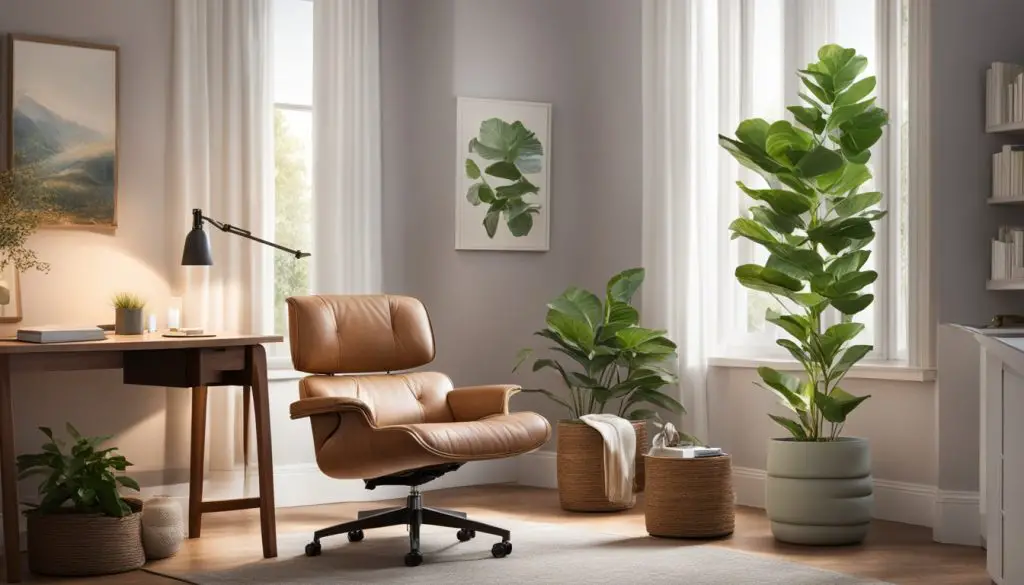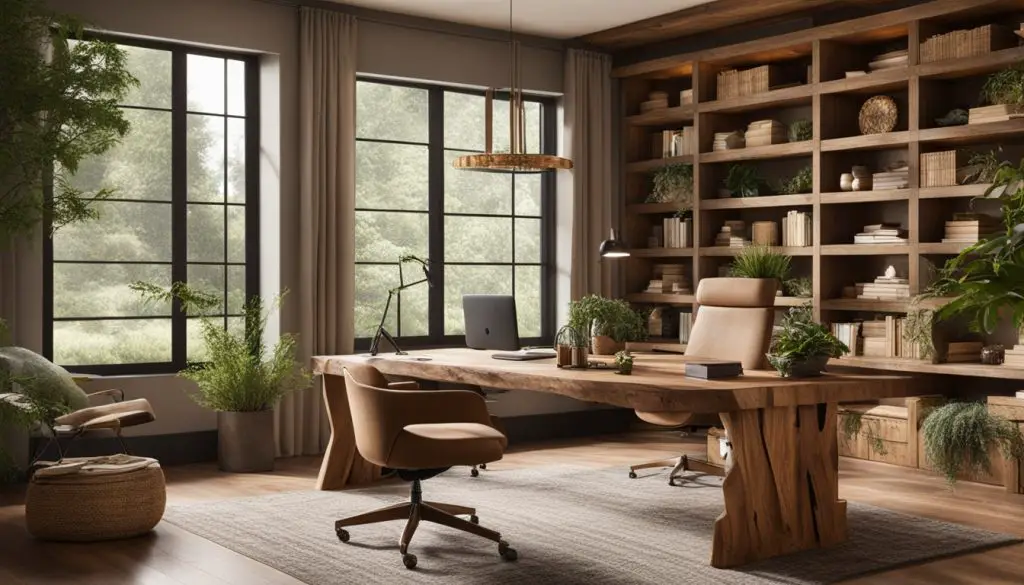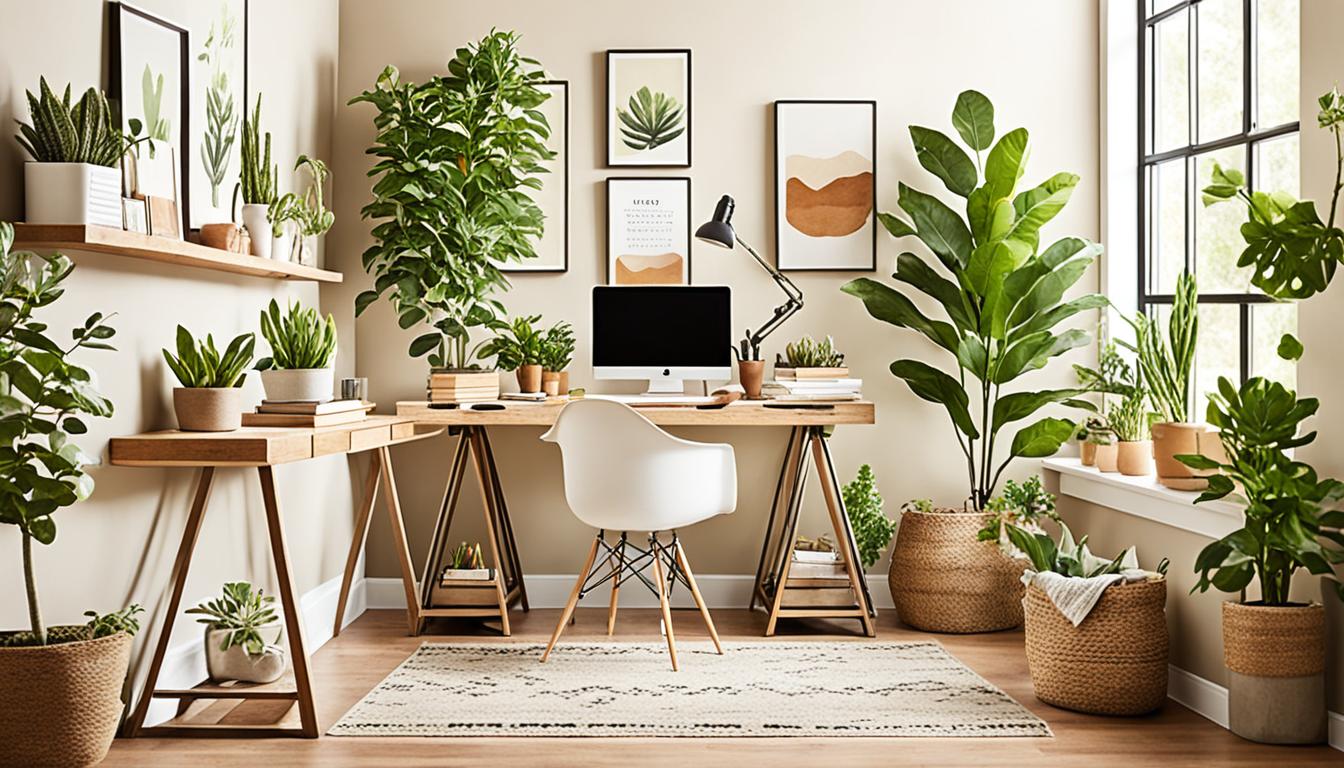My wife battles endometriosis and fibromyalgia. So, I’ve seen how a comfortable home can help manage chronic illness.1 Many Americans are living with chronic diseases. These illnesses can harm our bodies and minds. But making your home office more welcoming can bring relief and help you flourish, despite the challenges.
Studies show that wellness design and biophilic interiors soothe those with migraines, chronic pain, and depression. Using calming colors, natural light, clean air, and ergonomic furniture,1 you can make a space that boosts your well-being. Let’s explore how designing your home can better your health and give you back comfort and control.
Introduction to How Interior Design Affects Chronic Illness
Design changes in homes can really help people with chronic illnesses. They lower stress which is key for their well-being. Living with a chronic illness can be very hard. It affects your body, mind, and social life every day.2 If you suspect you might have a chronic illness, it’s vital to get checked by a doctor.
Importance of a Supportive Home Environment
Home design plays a big part in how people with chronic illnesses feel. A supportive home environment is crucial. It helps them control their symptoms and feel at ease at home.
Impact of Chronic Illness on Well-being
2 Many diseases, like arthritis and heart disease, can really change your life. They make it hard to do daily activities and cause a lot of pain. This can make you tired and weak.2 Coping with these health issues can also lead to depression and worry about money for medical care.2 But, there’s a way to find balance. It means dealing with the disease, changing how you live, and staying healthy in body and mind.2 The goal is to feel well in every way possible.
What Is Chronic Illness?
Chronic illnesses are serious conditions that last 3 months or more. They can’t be stopped by vaccines or healed by pills.2 These include migraines, chronic pain, and more severe problems like cancer or diabetes.2
Types of Chronic Illnesses
Issues such as migraines and cancer deeply impact life over a long time.2 Common examples are arthritis, cancer, and heart disease.2 Living with these conditions is a constant challenge.
Understanding Chronic Pain
Chronic pain is ongoing and lasts beyond 3 months. It includes fibromyalgia, osteoarthritis, and back pain.2 This pain affects physical, emotional, and social lives. If you think you have these issues, see a doctor.2 Early care can make symptoms less severe and improve your life.
Migraines: Designing for Relief
Migraines are a tough chronic illness. They bring intense pain and other symptoms like nausea and dizziness.2 They differ from normal headaches caused by stress. So, when creating spaces for migraine sufferers, light and color are vital for comfort.
Lighting Considerations for Migraines
Designing with proper light is key for managing migraines. Soft, natural light is best, avoiding harsh lights.2 With a well-thought-out lighting plan, those with migraines can lessen their symptoms.
Color Therapy for Migraines
Colors also play a big role in managing migraines. Cooler tones and soft colors have a calming effect for migraine sufferers.2 Using these colors in designing living spaces creates a relaxing place. It brings relief from the pain of migraines.
Chronic Pain: Creating a Comfortable Space
Chronic pain makes life very difficult for those who have it.1 It’s important to think about the right lighting, keeping the room at the right temperature, and using furniture that doesn’t stress the body.
Lighting and Temperature Control
To reduce discomfort, it’s vital to have the right light and temperature setup.1 You can do this by using natural light, adjustable lights, and controlling the temperature. This makes the home a more comfortable place for people with chronic pain.
Ergonomic Furniture and Accessories
Using the right furniture and tools can lower body stress.1 Choose items that are meant for comfort and function. This way, those with chronic pain can use their space without worsening their condition. They can also stay productive.
Using Colors and Patterns
Choosing the right colors and patterns can make a room feel calming.1 Go for soft colors, textures, and patterns. This helps create a peaceful environment. It’s a simple way for people with chronic pain to feel more relaxed at home.
Cancer: Promoting Comfort and Calm
Cancer can greatly affect how someone feels physically and emotionally.2 Designing a space focused on comfort and calm is key for cancer patients. Soft textures, calming colors, and gentle lighting help create a soothing environment.2
Designing for Relaxation
Making a space that is relaxing is important for cancer patients. Things like soft fabrics, quiet colors, and gentle lights calm the mind and body. Including comfy seats, peaceful art, and light scents can make this place even more relaxing.2
Creating Harmony and Serenity
For cancer patients, a peaceful space is crucial. Conditions like chronic pain and depression can make life very hard.2 A calm design with soothing colors and a balanced layout can lower stress. This is important since anxiety is a big issue for those with cancer.2

Mental Health: Interior Design for Well-being
Conditions like clinical depression are long-term issues that greatly affect happiness and health.1 Choosing the right colors and layout in a home can really help people feel better.
Color Psychology for Mental Health
Different colors and how things are arranged can change how we feel. They can bring calm or energy when we need it.1 Using colors in the right way can improve our well-being and make us feel more at home.
Layout Considerations
How a space is laid out affects how we feel at home too.1 Arranging items with care makes a peaceful place. This kind of design helps our mental health a lot.
Clinical Depression: Embracing Biophilia
Clinical depression is a serious mental health condition that can deeply affect a person’s life every day.2 To help people with this condition, using biophilic design is a smart choice. This design style brings nature indoors. It helps connect people to the outside world within their living spaces.
The Benefits of Nature
Things like natural light, plants, and nature-inspired materials are great for mood and health.2 They create a peaceful space that makes you feel close to nature. This can bring a sense of calm and well-being to those battling clinical depression.
Temperature Control for Comfort
Staying comfortable temperature-wise is key for people fighting depression.2 It helps avoid added physical stress. A well-regulated temperature also makes the surroundings more calming. This is especially important for those dealing with long-term mental health issues.
Cozy Home Office for Chronic Illness
Making a comfy and useful home office for those with chronic illness is key.1 It’s important to have things easy and accessible for them. Setting up what they need often takes a lot of trial and error.
Ergonomic Workspace Setup
An ergonomic workspace, with adjustable items, can ease symptoms and boost work.3 ABC Health noticed back and neck pain in 65% of those at home. This shows why ergonomics is vital.3 DEF Office Supplies reports a 40% rise in the sale of laptop stands. It’s clear people are looking for solutions to support their health.
Incorporating Nature and Natural Light
Nature elements, like plants and natural light, are key for peace and healing.2 Nature-based design is critical for a calm home. Research proves light and sound from nature help heal.
Choosing Calming Colors and Textures
Using relaxing colors and textures can really make a home office feel good.2 It includes things like soft colors, bright spaces, clean air, and plants. These make a space better for health and healing.2 Natural materials and colors help us relax and think better.
The Role of Nature in Biophilic Design
Biophilic design brings nature into buildings and helps people’s health. It improves the lives of those with chronic illnesses.4 Adding nature to our living and working spaces lowers stress. It also makes us feel better and more creative.
By using natural light and plants indoors, we make a peaceful space. This is especially good for people facing chronic health issues.
Bringing the Outdoors In
4 We spend most of our time, about 90%, inside. Good lighting, especially sunlight, helps our bodies’ daily rhythms and mood.4 Sunlight in our homes lifts our spirits, even in winter. It also affects how hungry we feel.
Plants indoors boost our health and the air we breathe. They support us to work better and be less stressed.4
Benefits of Biophilic Design
4 Biophilic designs lower stress, improve feelings, and help us think better. This is great for those with ongoing health issues.4 Warm living things, light, and color help relax us and sleep better.4 Good air flow and seeing the outdoors also make us feel good.
4 Using natural things in our decor brings nature in. Colors like green make spaces calm and healthful. They’re becoming more common in designs.
Simple steps like letting in light and including plants help a lot. They follow the powerful principles of Biophilic Design.
Research on Natural Light and Sound in Interiors
Studies show that natural light and sound have big benefits for people. This is especially true for those dealing with chronic illnesses. Natural light lifts moods, increases energy, and helps our body’s inner clock. It’s great for anyone with conditions like depression or chronic fatigue2. Adding sounds from nature or soft music can also reduce stress and anxiety.
Positive Effects of Natural Light
Letting in a lot of natural light can truly change how we feel, especially if we’re living with chronic illnesses. It boosts mood and energy, aligns our body clocks, and can help with depression or chronic fatigue2. Including large windows, skylights, or glass doors in our homes brings in a lot of natural light. This creates a space that feels calm and refreshing.
Sound Therapy for Relaxation
Alongside natural light, using sound therapy is important for those with chronic illnesses. Hearing nature sounds, like leaves in the wind or waves, can relax us and reduce stress. Listening to calm music also helps, making our space more peaceful and supportive. This approach is key for dealing with the emotional and psychological issues that come with chronic health problems.
Benefits of Natural Materials, Color & Texture within Living Spaces
Using natural materials, colors, and textures in homes can greatly benefit people with chronic illnesses.2 Materials like wood, stone, and natural fabrics create a peaceful setting. This setting helps in relaxing the mind.2 Choosing the right colors can also affect mood and thinking. Soft colors are best for those dealing with chronic pain or anxiety.2 Adding different textures aids in sensory stimulation. This benefit can be crucial for those wanting to feel grounded.
Natural Materials for a Calming Atmosphere
Creating a space with natural elements is especially calming for those with chronic health issues. Wooden items, stone details, and natural textiles calm the space. This calmness is ideal for people with chronic pain or anxiety.2 Such elements make a feel of the outdoors in their home. This connection to nature brings peace right at their home.
The Impact of Color on Well-being
Colors can also significantly affect the wellness of those with ongoing health problems.2 Soft colors like light blues, greens, and neutrals are soothing. They help with symptoms of migraines and depression. Bright colors, however, might be too stimulating for some. It’s key to ensure colors bring a sense of serenity.
Incorporating Texture for Sensory Stimulation
Textures alongside natural materials and colors can enrich a living space for those with chronic conditions.2 Soft fabrics, natural wood, and the touch of plants offer a comforting touch. They engage the senses in a way that brings comfort and grounding. This tactile approach helps in feeling at peace within their space.

How Residential Interior Design Affects Self-Care Practices at Home
Living with a chronic illness has shown me how critical a good home design is. It greatly helps me manage my health and focus on self-care. A comfortable and supportive home motivates me to take care of my physical, mental, and emotional health.5
My home design includes ergonomic furniture and nature-inspired elements. This design aids in reducing pain and tiredness. Also, it brings the calming effects of nature and light indoors. Such choices are vital for my self-care routine.5 Selecting the right colors, textures, and items transforms my space into a soothing retreat. This sanctuary meets my needs and aids in tackling the difficulties of my illness.6
The impact of home design on self-care is deep and wide-reaching. For instance, ergonomic setups boost productivity and ease pain. Natural elements also enhance my well-being and relaxation. They’re critical in my fight against my chronic illness and in balancing life.57
Source Links
- https://www.apartmenttherapy.com/how-chronically-ill-people-make-home-comfortable-36950267
- https://www.julieannrachelle.com/blended-decor-blog/wellness-design-for-chronic-illness
- https://truetherapyaz.com/creating-a-relaxing-home-workspace-for-comfort-and-productivity/
- https://www.thegirlwiththegreensofa.com/home/2019/5/30/biophillic-design
- https://www.ncbi.nlm.nih.gov/pmc/articles/PMC8871637/
- https://www.sarahbarnard.com/story/tag/wellness interior design
- https://www.healthdesign.org/insights-solutions/healthcare-home-white-paper
